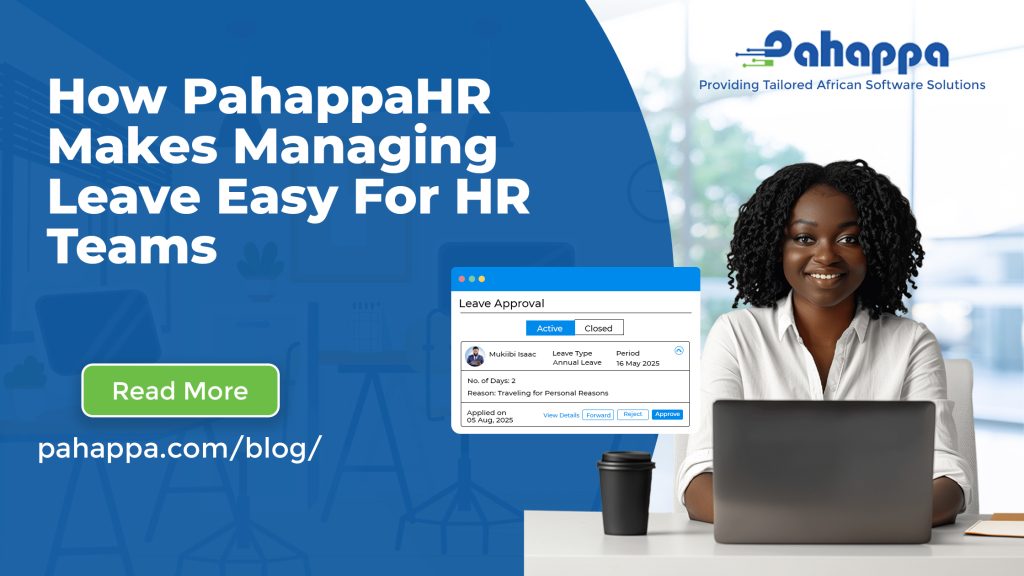Today, organizations with ten or more employees face a common challenge: managing HR tasks that often rely on manual processes, spreadsheets, and paperwork, along with constant follow-ups. What if you could move from reactive HR management to proactive workforce operations? By using automated HR processes, you can reduce administrative work, improve data accuracy, and allow your HR team to focus on strategy, culture, and growth.
Why HR Automation Matters for African Organisations
The administrative burden on HR teams
Many companies across Africa rely heavily on manual methods for tasks such as payroll, leave approvals, attendance tracking and performance reviews. When such processes are manual:
- HR teams chase signatures, hunt down spreadsheets and patch together leave balances manually.
- Delays in processing leave or payroll become common, resulting in frustrated employees and overworked HR staff.
- Errors in leave balances, payroll deductions or attendance hours happen more frequently.
- HR teams get stuck in “fire-fighting mode” rather than focusing on strategic work like culture, retention and talent development.
Growth intensifies complexity
As your company grows to 10 or more employees, your HR needs increase significantly. You will manage more types of leave (like annual, maternity, sick, and study), handle more requests, and deal with complicated payroll deductions. You may also have more branches and stricter compliance requirements. Without automation, the amount of administrative work can become overwhelming. In Africa, this challenge is even greater due to complex regulations and operations, such as multiple statutory deductions, new labor laws, and different leave types. This can create a heavy burden for businesses.
The benefits of moving to HR automation
Automating HR processes cuts down on administrative work, provides real-time insights and improves data accuracy. This allows HR to become a valuable partner instead of just a service center. For example:
- Automation improves productivity and accuracy: fewer errors in data entry, fewer lost files, less manual reconciliation.
- Automation supports compliance: the system can be configured to apply statutory deductions and leave rules so you don’t rely solely on memory or manual processes.
- Automation empowers employees through self-service: employees get quicker responses, access to their data themselves, reducing HR queries and improving satisfaction.
- Together, these benefits mean HR teams spend less time on admin, and more time on supporting business strategy, workforce planning and employee engagement.
Key Features of PahappaHR That Cut Administrative Work
When you assess an HR system, focus on features that cut down on manual tasks. Here are some key features and why they are important:
Payroll Management
A strong payroll module automates salary calculations, including deductions, allowances, contract changes, and approvals. For example, with a system like PahappaHR, you benefit from features such as payroll generation, contract tracking, and approval workflows. This leads to fewer mistakes, faster payroll processing, and better compliance with tax and labor laws. Automated payroll helps prevent late payments and incorrect payments and makes reconciliation easier, reducing audit risks and saving time for HR teams.
Leave Management
Leave requests, approvals, balance tracking and leave calendars can all be managed online by employees and managers. With automation:
- Employees submit leave via a portal, see their balance, and schedule time off.
- Managers review, approve, or reject with one click, and the system updates balances automatically.
- The system maintains historic leave records, prevents double booking, and integrates with attendance/time-tracking where needed.
- In manual systems, this often means back-and-forth emails, miscommunication, and hidden costs. Automating leave significantly reduces these administrative touchpoints.
Attendance and Time Tracking
Having accurate attendance data is essential for payroll, performance, and workforce planning. Automating this process involves managing shifts, tracking clock-ins and outs (using biometric devices or a mobile app), and connecting it with payroll and leave systems. In organizations where field workers, mobile staff, or multiple locations are common, automated time tracking helps prevent issues like “buddy-punching,” incorrect hour recordings, and the need for manual corrections. This ultimately saves HR time.
Performance and Employee Self-Service Portals
When employees can view their payslips, check their leave balances, and update their personal information on their own, the HR team does not need to spend time answering simple questions. A self-service portal gives employees more control. Performance modules that automate goal-setting, appraisal schedules, feedback reminders, and reporting help reduce the number of spreadsheets and lessen the administrative load of managing reviews. This change allows HR to focus more on strategic talent management instead of just administrative tasks.
Real-Time Analytics and Insights
Automated HR systems gather data continuously, such as leave usage, absenteeism trends, payroll costs per employee, and turnover rates. With dashboards and reports, HR teams can identify trends and respond quickly. Instead of searching for numbers in different systems, HR now has one reliable source of information. This saves time on report preparation and enables decision-makers to act more quickly.
Scalability, Integration & Localisation
An important factor is that HR software should fit local needs. This includes payroll deductions, leave laws, tax rules, currencies, and business practices. A system that can grow from 10 employees to hundreds and connect with other business systems (like ERP and accounting) helps avoid switching between different spreadsheets. Affordable options and local support are essential for small and medium-sized businesses (SMEs). These features help reduce difficulties and the extra work that comes with using systems not designed for the local market.
Why Choose PahappaHR for HR Automation?
Comprehensive HR Functionality
Manage every HR process in one platform, from recruitment and onboarding to performance reviews and offboarding. Keep all employee information organised and accessible in one place.
Automation and efficiency
Automate payroll, leave approvals, attendance tracking, and performance management. Reduce errors, save time, and let your HR teams focus on what truly matters.
Scalability and Affordability
Whether you have 10 or more employees, PahappaHR grows with your business. Get enterprise-level HR features at flexible prices that fit your budget
Conclusion
Automating HR processes is now essential for any organization that seeks to reduce administrative tasks, enhance efficiency, and empower its employees. By automating payroll, leave, attendance, performance, and self-service, you can shift HR from a reactive and transactional role to a strategic and value-adding one.
With HR software like PahappaHR designed for African businesses, organizations can enjoy benefits such as streamlined operations, more accurate data, and a more engaged workforce. This means less time on admin tasks and more time focused on growth.
Are you ready to improve your HR operations? Book a free PahappaHR demo to begin your automation journey today.






